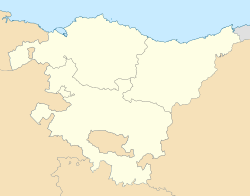Añana facts for kids
Quick facts for kids
Añana
|
||
|---|---|---|

Village of Salinas de Añana
|
||
|
||
| Country | Spain | |
| Autonomous community | Basque Country | |
| Province | Álava | |
| Comarca | Cuadrilla de Añana | |
| Area | ||
| • Total | 21.92 km2 (8.46 sq mi) | |
| Population
(2018)
|
||
| • Total | 151 | |
| • Density | 6.889/km2 (17.84/sq mi) | |
| Time zone | UTC+1 (CET) | |
| • Summer (DST) | UTC+2 (CEST) | |
| Postal code |
01423
|
|
| Official language(s) | Basque, Spanish | |
Añana is a special place in northern Spain. It is both a valley and a municipality, which is like a small town or district. Añana is located in the Álava province, within the Basque Country.
The main village in Añana is called Salinas de Añana. In the Basque language, this village is known as Basque: Gesaltza Añana. Añana is also the name of one of the seven areas that make up the province of Álava. This town is famous for its very old salt flats. These salt flats began to form a very long time ago, during the Triassic Period.
The Amazing Salt Valley
The Salt Valley of Añana is a unique place. Here, salty water comes out of natural springs. People collect this water and let it sit in special shallow pools called pans. The sun and wind then make the water evaporate, leaving behind the salt. This method of getting salt has been used for a very long time.
A Long History of Salt Production
Archaeologists have found proof that people have been making salt here for about 7,000 years. This makes it the oldest place in the world where salt is still produced! The salt pans you see today were mostly built around the first century BCE, during the time of Ancient Rome.
Over 5,000 salt pans have been created since Roman times. Selling this salt was a big business. The town even got special rights in the year 1114 to help with salt trade. The Spanish crown took control of salt production in 1564 and managed it until 1868.
Restoring the Salt Pans
By the 1970s, making salt in Añana became less popular. It was cheaper to get salt from the sea. So, many of the salt pans were left empty.
However, at the end of the 20th century, people started to restore the salt pans. A group began working to save them without making a profit. Today, they produce special "gourmet" salts, which are high-quality salts used in cooking. They also offer spa tourism, where people can visit and enjoy the salty waters. This helps bring money to the area. In 2019, the site was added to the European Route of Industrial Heritage. This means it is recognized as an important historical industrial site in Europe.
See also
 In Spanish: Añana para niños
In Spanish: Añana para niños




